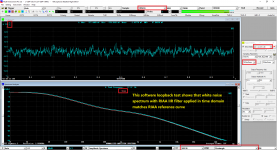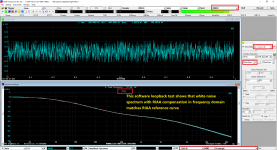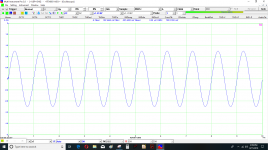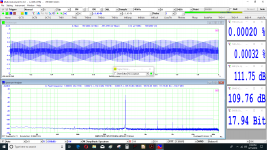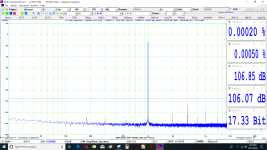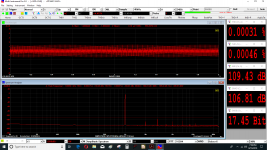Getting two error messages 'fail to start DAQ' and 'fail to start DAO'. Thought I would ask in case there is an obvious answer before i investigate further. Using trial version until dongle arrives, installed ASIO drivers and selected the RTX with ASIO. RTX shows as under remote control.
RIAA Testing
Virtins,
With MI Pro and RTX6001, is it possible to test the frequency response of a RIAA Phonostage without building an inverse RIAA filter from caps and resistors, attaching it to the DUT and running frequency sweeps? It would be lovely if it was possible to sweep the Phonostage directly (no inverse RIAA filter) and correlate the resulting frequency response to the RIAA curve in software. Is this possible in MI Pro?
Cheers,
Anthony
Virtins,
With MI Pro and RTX6001, is it possible to test the frequency response of a RIAA Phonostage without building an inverse RIAA filter from caps and resistors, attaching it to the DUT and running frequency sweeps? It would be lovely if it was possible to sweep the Phonostage directly (no inverse RIAA filter) and correlate the resulting frequency response to the RIAA curve in software. Is this possible in MI Pro?
Cheers,
Anthony
Last edited:
RIAA
Thank you for your questions.
Yes, it is possible. There are three methods:
Method 1. Apply Recording RIAA IIR filter in time domain (Oscilloscope)
Right click anywhere within the oscilloscope window and select [Oscilloscope Processing]>”Digital Filtering”>”Arbitrary”>”IIR Coefficients” and then load a preconfigured Recording RIAA IIR coefficient file, e.g.:
(1) RecordingRIAA_SR44100Hz_IIR_Order2.iir
(2) RecordingRIAA_SR48000Hz_IIR_Order2.iir
(3) RecordingRIAA_SR88200Hz_IIR_Order2.iir
Note that the sampling rate of the IIR coefficient file must match the sampling rate of the oscilloscope.
In MI, generally the acquired signal will be processed in time domain (Oscilloscope) first and then flows to frequency domain (Spectrum Analyzer). Please refer to Section 1.6 Signal Flow Block Diagram of the software for details if you want to configure your own DSP processing and analysis algorithm.
After the above Recording RIAA filtering in time domain, if the frequency response of the DUT follows Reproducing RIAA exactly, then the measured magnitude frequency response in the Spectrum Analyzer should be a flat horizontal line.
Method 2. Apply Recording RIAA frequency compensation in frequency domain (Spectrum Analyzer)
Right click anywhere within the spectrum analyzer window and select [Spectrum Analyzer Processing]>”Intra-Frame Processing” > ”Compensation1” and then load the frequency compensation file: RecordingRIAA.fcf.
If the frequency response of the DUT follows Reproducing RIAA exactly, then the measured magnitude frequency response in the Spectrum Analyzer should be a flat horizontal line.
Note that the time domain waveform will not be affected by this method, unlike the previous one.
Method 3. Check the measured magnitude frequency response directly against the Reproducing RIAA reference curve
To load the reference curve, right click anywhere within the spectrum analyzer window and select [Spectrum Analyzer Reference] and then load ReproducingRIAA.ref. It is advisable to load this reference curve in a channel different than the channel where the measured frequency response curve resides, so that you can adjust the vertical offset between the two curves for easier comparison. To hide the real-time spectrum in the reference channel, set its color to the background color.
The following are two examples using white noise as stimulus through software loopback (iA=oA, iB=oB). White noise spectrum is flat.
(1) A ReproducingRIAA IIR filter is applied in the oscilloscope. The measured spectrum matches the Reproducing RIAA reference curve.
(2) A ReproducingRIAA frequency compensation file is configured in the spectrum analyzer. The measured spectrum matches the Reproducing RIAA reference curve.
Thank you for your questions.
Yes, it is possible. There are three methods:
Method 1. Apply Recording RIAA IIR filter in time domain (Oscilloscope)
Right click anywhere within the oscilloscope window and select [Oscilloscope Processing]>”Digital Filtering”>”Arbitrary”>”IIR Coefficients” and then load a preconfigured Recording RIAA IIR coefficient file, e.g.:
(1) RecordingRIAA_SR44100Hz_IIR_Order2.iir
(2) RecordingRIAA_SR48000Hz_IIR_Order2.iir
(3) RecordingRIAA_SR88200Hz_IIR_Order2.iir
Note that the sampling rate of the IIR coefficient file must match the sampling rate of the oscilloscope.
In MI, generally the acquired signal will be processed in time domain (Oscilloscope) first and then flows to frequency domain (Spectrum Analyzer). Please refer to Section 1.6 Signal Flow Block Diagram of the software for details if you want to configure your own DSP processing and analysis algorithm.
After the above Recording RIAA filtering in time domain, if the frequency response of the DUT follows Reproducing RIAA exactly, then the measured magnitude frequency response in the Spectrum Analyzer should be a flat horizontal line.
Method 2. Apply Recording RIAA frequency compensation in frequency domain (Spectrum Analyzer)
Right click anywhere within the spectrum analyzer window and select [Spectrum Analyzer Processing]>”Intra-Frame Processing” > ”Compensation1” and then load the frequency compensation file: RecordingRIAA.fcf.
If the frequency response of the DUT follows Reproducing RIAA exactly, then the measured magnitude frequency response in the Spectrum Analyzer should be a flat horizontal line.
Note that the time domain waveform will not be affected by this method, unlike the previous one.
Method 3. Check the measured magnitude frequency response directly against the Reproducing RIAA reference curve
To load the reference curve, right click anywhere within the spectrum analyzer window and select [Spectrum Analyzer Reference] and then load ReproducingRIAA.ref. It is advisable to load this reference curve in a channel different than the channel where the measured frequency response curve resides, so that you can adjust the vertical offset between the two curves for easier comparison. To hide the real-time spectrum in the reference channel, set its color to the background color.
The following are two examples using white noise as stimulus through software loopback (iA=oA, iB=oB). White noise spectrum is flat.
(1) A ReproducingRIAA IIR filter is applied in the oscilloscope. The measured spectrum matches the Reproducing RIAA reference curve.
(2) A ReproducingRIAA frequency compensation file is configured in the spectrum analyzer. The measured spectrum matches the Reproducing RIAA reference curve.
Attachments
Last edited:
What is up with the MI Pro installation location?
I am finally getting some time to install the RTX MI Pro (dongle arrived today), but I'm already hung up at the first step. MI Pro says it wants to install here:
MI Pro says it wants to install here:
C:\VIRTINS Multi-Instrument 3.8
Wrong answer. On Windows 10 here (or any of the recent Windows OSes) it should go into C:\Program Files if a 64 bit app or C:\Program Files (x86) if a 32 bit app, of course. Which brings up the related question... is MI Pro 32 bit or 64 bit?
Maybe what is being installed is a zip or other archive self-unpack that will in turn properly install itself into one of these two locations and then leave behind the delete-able archive folder? I had a program install work that way just last week. If so then a few words to that effect on the installer would be monumentally useful.
One of my pet peeves over the years is software that wants to install itself in C:\, lol like the Windows 3.1 days.
I see the the MI Pro software will allow me to change the installation location, but I need to find out if doing so (changing it to one of the above) will mess it up. So... Virtins, MI Pro, or anyone else who knows please advise.
Thanks!
I am finally getting some time to install the RTX MI Pro (dongle arrived today), but I'm already hung up at the first step.
C:\VIRTINS Multi-Instrument 3.8
Wrong answer. On Windows 10 here (or any of the recent Windows OSes) it should go into C:\Program Files if a 64 bit app or C:\Program Files (x86) if a 32 bit app, of course. Which brings up the related question... is MI Pro 32 bit or 64 bit?
Maybe what is being installed is a zip or other archive self-unpack that will in turn properly install itself into one of these two locations and then leave behind the delete-able archive folder? I had a program install work that way just last week. If so then a few words to that effect on the installer would be monumentally useful.
One of my pet peeves over the years is software that wants to install itself in C:\, lol like the Windows 3.1 days.
I see the the MI Pro software will allow me to change the installation location, but I need to find out if doing so (changing it to one of the above) will mess it up. So... Virtins, MI Pro, or anyone else who knows please advise.
Thanks!
Last edited:
I let it do the default installation tonight and it worked right off the bat. My understanding of the software is limited, and the whole system went down when the keyboard usb dongle fried.
Had a lightning strike nearby last week-end that taking its toll on a day by day basis. Keeping my fingers crossed that the new NUC or RTX is not next.
I tried installing UTgui in the programx86 directory which resulted in some very interesting malfunctions so I would install Virtins where it wants to go. UTgui now works fine since installing it where it wanted to go.
Here are some captures.
Had a lightning strike nearby last week-end that taking its toll on a day by day basis. Keeping my fingers crossed that the new NUC or RTX is not next.
I tried installing UTgui in the programx86 directory which resulted in some very interesting malfunctions so I would install Virtins where it wants to go. UTgui now works fine since installing it where it wanted to go.
Here are some captures.
Attachments
Really good results. Lightning can be really devastating. I would recommend for both the test stuff and any AV system start with a good UL approved surge suppressor and (very important) no outside cables (phone, coax, network) connect to anything inside the protected area without passing through the surge suppressor. beware of other ground returns to mother earth. They all need to converge at the suppressor or the differential will fry things. I have seen several TV's and satellite boxes where the internal ground connections are all fried because the consumer did not follow these rules. And, if there is significant potential for lightning near you, unplug anything important. Even a nearby strike that doesn't hit wiring can induce a lot of energy. The current and the risetime of a real hit can be amazing. Peak current of 30,000 A and a risetime of 8 microseconds or less. Fortunately inside a building at an outlet, it's more like 3000A but still that's a lot of radiated EMI.
Thanks guys!  I'll let it install in C:\ then, but I'll register a suggestion with Virtins here to please put that on the "things to do" list. There really shouldn't be any reason why it can't be written to run properly in Program Files or Program Files (x86). I understand lumping it in C: is probably easy(er), but no other piece of software I've run into in recent years, except for one instrumentation thing from NI (lol, same issue) wants to be in C:\. Looks bad, IMHO.
I'll let it install in C:\ then, but I'll register a suggestion with Virtins here to please put that on the "things to do" list. There really shouldn't be any reason why it can't be written to run properly in Program Files or Program Files (x86). I understand lumping it in C: is probably easy(er), but no other piece of software I've run into in recent years, except for one instrumentation thing from NI (lol, same issue) wants to be in C:\. Looks bad, IMHO. 
Hey on the lightning damage - something to consider, I put a whole house surge suppressor right at the outdoor electric service entrance a year ago. This guy:
https://www.homedepot.com/p/Eaton-Whole-House-Surge-Protector-CHSPT2ULTRA-1/204761136
Fairly easy install, mounts in a 1/2" knockout and is feed by a double pole 50A breaker.
Hey on the lightning damage - something to consider, I put a whole house surge suppressor right at the outdoor electric service entrance a year ago. This guy:
https://www.homedepot.com/p/Eaton-Whole-House-Surge-Protector-CHSPT2ULTRA-1/204761136
Fairly easy install, mounts in a 1/2" knockout and is feed by a double pole 50A breaker.
Last edited:
The whole house suppressor is a good start, but doesn't let you out of managing all the other cables. Also, a big hit nearby will induce currents all over the building. You really can't have too many surge suppressors in the building. Look for ones with 350V or 400V let through ratings to get a good one. Lower joules but works better.
Thanks Demian, I purchased a couple of Zero Surge units and the first two arrived today. I've installed them and I plan to add another which I ordered tonight once it gets here.
We may do a whole building surge protector, but not sure yet.
The NUC and RTX seem to be OK. I am not sure why the wireless keyboard dongle self destructed but it did. Keyboard replaced and everything worked fine for 5 hours continuously tonight. The NUC didn't get nearly as hot as last night.
We may do a whole building surge protector, but not sure yet.
The NUC and RTX seem to be OK. I am not sure why the wireless keyboard dongle self destructed but it did. Keyboard replaced and everything worked fine for 5 hours continuously tonight. The NUC didn't get nearly as hot as last night.
Attachments
The latest but unofficial download link is at: http://www.virtins.com/MIsetup3.8.2.2.exe. (English Version only). We are still doing some updates to make it official.
Hi guys, where am I supposed to get the software? Is there a download link for the group buy?
Okay, I found two links in the mail, but after installation. Starting up it will ask for a sound card. Do I have to have the RTX plugged in? It does not seem to be on the list.
Yes the rtx has to be plugged in and turned on.
Hi to all.
Just I returned from my summer holidays and I downloaded the trial version 3.8.2.2 (I haven't the hw usb key yet)
I played a little with it, but I heven't read the manual yet.
I saw for the oscilloscope or spectrum analyser for example, does not move to another display, if you use two displays on your computer with extended mode.
But, some others like signal generator, device under plan can to move to the second display.
I think that it is important to have the spectrum analyser to the second display and the rest to the other or similar combination to extended displays mode.
Is that something that can be corrected to the next version?
Just I returned from my summer holidays and I downloaded the trial version 3.8.2.2 (I haven't the hw usb key yet)
I played a little with it, but I heven't read the manual yet.
I saw for the oscilloscope or spectrum analyser for example, does not move to another display, if you use two displays on your computer with extended mode.
But, some others like signal generator, device under plan can to move to the second display.
I think that it is important to have the spectrum analyser to the second display and the rest to the other or similar combination to extended displays mode.
Is that something that can be corrected to the next version?
- Status
- This old topic is closed. If you want to reopen this topic, contact a moderator using the "Report Post" button.
- Home
- Group Buys
- GB for Virtins MI Pro for RTX6001 autoranging/autoscaling & for soundcard end users
